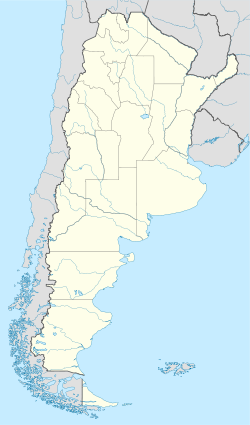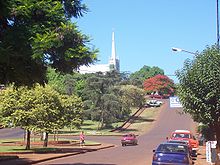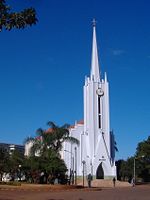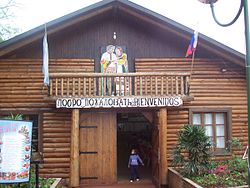- Oberá
-
Oberá — City — Location of Oberá in Argentina Coordinates: 27°29′S 55°8′W / 27.483°S 55.133°WCoordinates: 27°29′S 55°8′W / 27.483°S 55.133°W Country Argentina Province Misiones Department Oberá Population – Total 55,493 Time zone ART (UTC-3) CPA base N3360 Dialing code +54 3755 Oberá is a city in the interfluvial province of Misiones, Argentina, and the head town of the Oberá Department. It is located 96 km east of the provincial capital Posadas, on National Route 14, and about 1,150 km north of Buenos Aires. It has about 55,000 inhabitants according to the 2001 census [INDEC].
Contents
Overview
Oberá is the second city in size and importance of the province, and the core of the Sierras Centrales region. The area is a colorful landscape, with luxurious vegetation, streams, cascades and hilly areas. Oberá is also the educational and cultural capital of the central region of the province, with availability of universities and colleges (such as the National University of Misiones). Its economy is based on agriculture and industry.
The local culture is marked by European influences, since the area was settled by numerous colonies of immigrants, starting in 1897. The first community that settled in the site of today's Oberá (then known as Villa Svea) arrived in 1909 and was composed of Swedes. French, Norwegian, Finns, Russian, German, English, Lebanese and Danish joined them, before and after World War I.
Oberá was officially founded on 9 July 1928. Its name was taken from a renowned aboriginal chief, and it means "bright, shining". More than 15 national/ethnic communities of people descended from immigrants coexist, keeping their legacy and traditions. In the first fortnight of September every year they celebrate this diversity with the Immigrant's Festival.
Oberá is also known as the "City of the Churches", since it features more than 30 churches, belonging to a diversity of denominations (including Eastern and Western Catholic rites, Eastern Orthodox, and several Evangelical/Protestant churches). On June 13, 2009, Oberá was made the see of the newly erected Roman Catholic Diocese of Oberá. The latter was created with territory carved out from the Diocese of Posadas.
Tourist attractions
In addition to the many churches, other tourist sites include:
- Jardín de los Pájaros (Birds' Garden), showcasing more than 200 species of birds.
- Monteaventura, a recreational estate with ecological footpaths and games.
- Salto Berrondo (Berrondo Waterfall), a forest area with camping facilities.
- Reserva del Chachí, a nature reserve near the city, featuring chachís (giant ferns).
- Centro Zootoxicológico, with a diversity of reptiles, including one of the largest serpentaries in the country.
- Oberá Park, a summer recreation center.
- Parque de las Naciones (Park of the Nations), devoted to typical houses of the immigrant communities.
- Historic and Natural Sciences Museum
- Casa de la Cultura' (Culture House), with exhibitions of diverse artists.
Other attractions include visits to small farms and plantations, including those of yerba mate and tea, the major products of Misiones.
External links
- Official website
- Oberá Online
- Press article about Oberá City and documentary (in Spanish only)
- Fiesta del Inmigrante (Immigrant's Festival official website)
References
TC 2000 Championship Seasons Current cars (2011) Chevrolet Cruze • Fiat Bravo • Honda Civic Si • Toyota Corolla • Renault Fluence • Volkswagen Golf • Volkswagen Polo • Ford Focus • Peugeot 307Current circuits Córdoba • General Roca • Oberá • Jorge Ángel Pena • Río Hondo • Resistencia • Santa Fe • Buenos Aires • Centenario • Punta del Este (Uruguay) • Eduardo Copello • San LuisFormer circuits Bahía Blanca • Comodoro Rivadavia • Güemes • Curitiba (Brazil) • Interlagos (Brazil) • Paraná • ViedmaCategories:- Populated places in Misiones Province
- Populated places established in 1928
Wikimedia Foundation. 2010.





